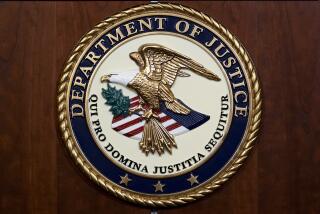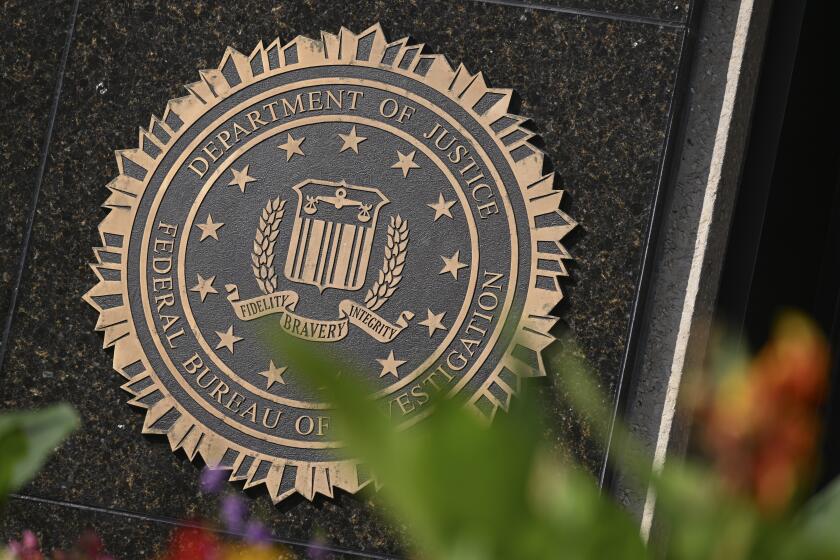BP puts tighter cap on leaking well
BP lowered a new, tight-fitting containment cap over its renegade well in the Gulf of Mexico late Monday, which may give the company the ability to shut off the flow of oil completely if tests show that the well is in good enough structural shape to be bottled up at the top.
Live video from undersea robots showed the massive piece of machinery being lowered onto the well Monday evening, raising the possibility that after 84 days of gushing oil, the wound in the earth a mile below the gulf’s surface could soon be stanched.
In Washington, the Obama administration chose to reopen a high-stakes legal and political battle by introducing a new moratorium on deep-water drilling in the Gulf of Mexico.
Last month, a federal judge ruled that the administration had acted “arbitrarily and capriciously” in issuing the original moratorium in May. The administration’s push was sure to add fuel to a debate between Americans worried about the oil companies’ disaster preparedness and others, including Louisiana officials, who say the moratorium will cost an already beleaguered region thousands of jobs and increase U.S. dependence on foreign oil.
BP’s announcement came couched in caveats, given its previous failed attempts at solving the problem since the rig it was leasing exploded April 20 off the coast of Louisiana: A company statement noted that the cap system had “never before been deployed at these depths under these conditions” and that its effectiveness “cannot be ensured.”
But there were also signs of cautious optimism Monday. Overnight Sunday, the company was able to install a crucial piece of equipment called a transition spool, which was attached to the existing hardware on the well.
“The riskiest part is now over with,” said Eric Smith, associate director of the Tulane Energy Institute.
The spool allowed remotely operated submarines to attach the 18-foot-high, 150,000-pound cap equipped with three hydraulic rams that should have the ability to stop the oil from flowing, according to Doug Suttles, BP’s chief operating officer for exploration and production.
Once the cap is in place, the company will “close in,” or seal off, the well to prevent any oil from escaping. Then, in a process that could take six to 48 hours or longer, tests of the pressure inside the well will be conducted and analyzed by BP and government experts.
If the pressure is high, it probably means that the deep well beneath the ocean floor is in good shape. “At that point, we would be able to leave the well shut in,” Suttles said.
If the pressure is found to be low, it could indicate that there is a problem with the integrity of the well — a concern government and other experts have expressed since at least May.
If the oil has been leaking outside of the well casing, affixing the cap could push more of it out and up to the seafloor in the area around the well. That could potentially create a wide, unmanageable crater of gushing oil, said Iraj Ershaghi, a professor of petroleum engineering at the University of Southern California.
“That would be disastrous,” Ershaghi said. “There’s a lot of risk involved here.”
Retired Coast Guard Adm. Thad Allen, who is overseeing the spill response for the government, said he and a team of government scientists had reviewed the test protocols.
“BP will be in regular contact with the government during the test, and the government will halt the test if the risks of doing further damage to the surrounding formation are significant,” Allen said in a statement.
If the well fails the test, Suttles said, the company will unseal the containment cap and continue its constantly evolving plan of collecting oil at the wellhead and sending it through riser pipes to surface ships.
The company has two ships able to take in a fraction of the 35,000 to 60,000 barrels of oil flowing daily from the well. As of Monday, the company could take up about 8,000 barrels per day, but that number is expected to increase to 60,000 to 80,000 barrels daily by the end of July as new ships and technology are introduced. The maximum containment plan is possible only with the successful installment of the new cap, said Daren Beaudo, a BP spokesman.
Many potential pitfalls remain. Suttles said he was particularly concerned that ice-like crystals called hydrates could form in the cap, a problem the company encountered in an earlier attempt to place a huge steel and concrete box over the well.
Even if the cap is used to stop all of the oil from leaking at the top of the well, Suttles said, it still will be necessary to permanently seal it far below the earth’s surface with a relief well, which is intended to jam the broken well with drilling mud and concrete. The closest of two relief wells being drilled is at more than 17,800 feet below sea level and is expected to allow BP to begin plugging the well in mid-August.
The Interior Department, meanwhile, was hopeful Monday that the new drilling moratorium, which could last through Nov. 30, would withstand a court challenge because it focuses on drilling technologies, not water depths.
In a memo to congressional offices, the Interior Department said the “temporary pause” is intended to provide time for drillers to demonstrate “that they have the ability to respond effectively to a potential oil spill in the gulf, given the unprecedented commitment of available oil spill response resources that are now being dedicated to the BP oil spill.” It also is intended to allow time for an examination of the causes of the April 20 explosion, including a better understanding of the problems with the supposedly fail-safe blowout preventer.
The moratorium could end sooner, according to the memo, if Interior Secretary Ken Salazar is satisfied that his safety concerns are addressed.
The action came as one drilling rig, owned by Diamond Offshore, prepared to leave the gulf for Egypt. The company has said it was leaving as “a result of the uncertainties surrounding the offshore drilling moratorium.”
Jack Gerard, president and chief executive officer of the American Petroleum Institute, the oil industry trade group, criticized the new moratorium as “unnecessary and shortsighted.”
“The government has already imposed significant, additional safety requirements that are supported by the industry,” he said. “A resumption of drilling would proceed only under the most intense and vigilant oversight.”
Rep. Charlie Melancon (D-La.) said he was “deeply disappointed” with the new moratorium. “At a time when we are already suffering from the BP oil disaster in the gulf, this continued suspension will cost our state more jobs and revenue,” he said. “Louisianans have had enough and want to get back to producing energy for our nation.”
But Salazar said it was up to the industry to “raise the bar.”
White House Press Secretary Robert Gibbs said the president “continues to believe that we have to be careful with what we’re doing, given the uncertainty around what happened 84 days ago.”
In New Orleans on Monday, the commission appointed by President Obama to study the cause of the disaster held its first public hearing in a half-filled hotel ballroom.
Critics, including some Democrats, have charged that the seven-member panel is stacked with environmentalists who oppose offshore drilling and have no expertise in drilling or petroleum engineering.
The co-chairman, Bob Graham, a former governor and U.S. senator from Florida, sought to address those concerns when he vowed to run a “science- and fact-driven investigation … without any political considerations or preconceived objectives.”
Simon reported from Washington and Fausset from Atlanta. Times staff writers Nicole Santa Cruz and Bob Drogin in New Orleans contributed to this report.
More to Read
Sign up for Essential California
The most important California stories and recommendations in your inbox every morning.
You may occasionally receive promotional content from the Los Angeles Times.










